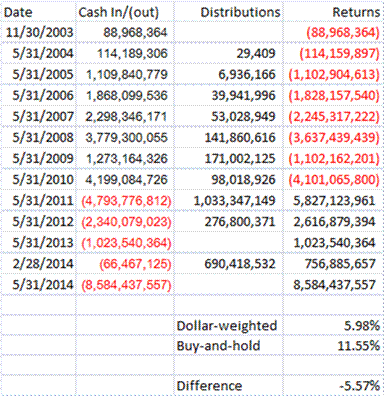Mantra: Interest Rates Have to Rise, Interest Rates Have to…

I thought of structuring this post like a fictional story, but I couldn’t figure out how to make it good enough for publication. ?Well, truth is often stranger than fiction, so have a look at this Bloomberg article pointing at a 37% loss in the?ProShares UltraShort 20+ Year Treasury (TBT).
A few points to start with: shorting is hard. ?Leveraged shorting is harder. ?I think I have reasonable expertise in much though not all of investing, and I put most shorts in the “too hard pile.”
That said, I have taken issue with the “interest rates can only go up” trade for 8-9 years now. ?It is not a major theme of mine, but I remember a disagreement that I had with Cramer over it back when I was writing for RealMoney. ?(I would point to it now, but almost all content at RealMoney prior to 2008 is lost.)
Many bright investors (usually not professional bond investors) have taken up the?”interest rates can only go up” view because of the loose monetary policy that we have experienced, and thanks to Milton Friedman, we know that “Inflation is always and everywhere a monetary phenomenon,” or something like that.
Friedman may or may not be right, but when banks do not turn the proceeds of?deposits into loans, inflation doesn’t do much. ?As it is, monetary velocity is low, with no signs of imminent pickup.
At least take time to read the views of those who are long a lot of long Treasuries, and have been that way for a long time — Gary Shilling and Hoisington Management. ?Current economic policies are not encouraging growth, and that is true over most of the world. ?We have too much debt, and the necessary deleveraging inhibits growth.
Think of this a different way: we have a lot of people thinking that they will retire over the next 10-30 years. ?To the extent that you can live with the long-run volatility, I accept the idea that you can earn 6-8%/year in stocks over that period, so long as there isn’t war on your home soil, or a massive increase in socialism.
But what if you are running a defined-benefit plan, investing to back long-dated insurance products, or just saying that you need some degree of nominal certainty for?some of your assets. ?The answer would be debt claims against institutions that you know will be around to pay 10-30 years from now.
In an era of change, how many institutions are you almost certain will be here 10-30 years from now? ?Personally, I would be comfortable with most government, industrial and utility bonds rated single-A or better. ?I would also be comfortable with some municipal and financial company bonds with similar ratings.
If followed, and this has been followed by many institutional bond investors, this would result in falling long-term yields, particularly now when economic growth is weak globally.
Now, rates have fallen a great deal over 2014. ?Can they fall further from here? ?Yes, they can. ?Is it likely? ?I don’t know; they have fallen a lot faster than I would have expected.
I would encourage that you watch bank lending, and to a lesser extent, inflation reports. ?The time will come to end the high quality long bond trade, but at present, who knows? ?Honor the momentum for now.
Full Disclosure: Long TLT for my fixed income clients and me (it’s a moderate?part of a diversified portfolio with a market-like duration)



